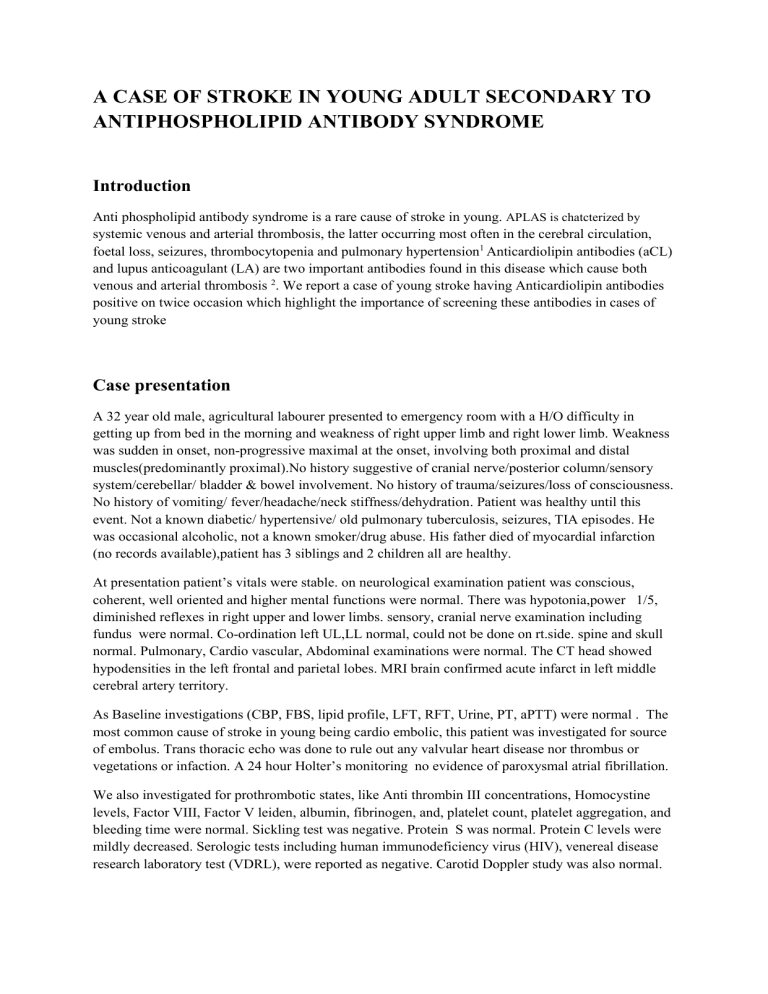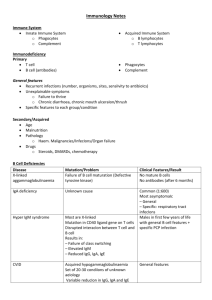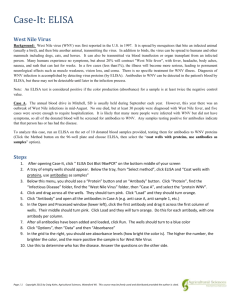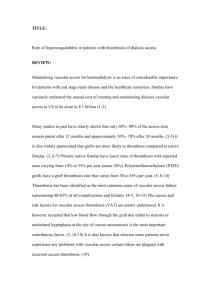A CASE OF STROKE IN YOUNG ADULT SECONDARY TO

A CASE OF STROKE IN YOUNG ADULT SECONDARY TO
ANTIPHOSPHOLIPID ANTIBODY SYNDROME
Introduction
Anti phospholipid antibody syndrome is a rare cause of stroke in young. APLAS is chatcterized by systemic venous and arterial thrombosis, the latter occurring most often in the cerebral circulation, foetal loss, seizures, thrombocytopenia and pulmonary hypertension 1 Anticardiolipin antibodies (aCL) and lupus anticoagulant (LA) are two important antibodies found in this disease which cause both venous and arterial thrombosis 2 . We report a case of young stroke having Anticardiolipin antibodies positive on twice occasion which highlight the importance of screening these antibodies in cases of young stroke
Case presentation
A 32 year old male, agricultural labourer presented to emergency room with a H/O difficulty in getting up from bed in the morning and weakness of right upper limb and right lower limb. Weakness was sudden in onset, non-progressive maximal at the onset, involving both proximal and distal muscles(predominantly proximal).No history suggestive of cranial nerve/posterior column/sensory system/cerebellar/ bladder & bowel involvement. No history of trauma/seizures/loss of consciousness.
No history of vomiting/ fever/headache/neck stiffness/dehydration. Patient was healthy until this event. Not a known diabetic/ hypertensive/ old pulmonary tuberculosis, seizures, TIA episodes. He was occasional alcoholic, not a known smoker/drug abuse. His father died of myocardial infarction
(no records available),patient has 3 siblings and 2 children all are healthy.
At presentation patient’s vitals were stable. on neurological examination patient was conscious, coherent, well oriented and higher mental functions were normal. There was hypotonia,power 1/5, diminished reflexes in right upper and lower limbs. sensory, cranial nerve examination including fundus were normal. Co-ordination left UL,LL normal, could not be done on rt.side. spine and skull normal. Pulmonary, Cardio vascular, Abdominal examinations were normal. The CT head showed hypodensities in the left frontal and parietal lobes. MRI brain confirmed acute infarct in left middle cerebral artery territory.
As Baseline investigations (CBP, FBS, lipid profile, LFT, RFT, Urine, PT, aPTT) were normal . The most common cause of stroke in young being cardio embolic, this patient was investigated for source of embolus. Trans thoracic echo was done to rule out any valvular heart disease nor thrombus or vegetations or infaction. A 24 hour Holter’s monitoring no evidence of paroxysmal atrial fibrillation.
We also investigated for prothrombotic states, like Anti thrombin III concentrations, Homocystine levels, Factor VIII, Factor V leiden, albumin, fibrinogen, and, platelet count, platelet aggregation, and bleeding time were normal. Sickling test was negative. Protein S was normal. Protein C levels were mildly decreased. Serologic tests including human immunodeficiency virus (HIV), venereal disease research laboratory test (VDRL), were reported as negative. Carotid Doppler study was also normal.
Immunological markers for Anti nuclear antibody was positive, Anti cardiolipin antibody- positive. lupus anti coagulant, anti b2-gp1 antibodies were negative. His weakness persisted for 3 days followed by gradual recovery. Patient was put on heparin followed by warfarin. At the time of discharge patient had 4/5power in Rt.UL,5/5 in Rt.LL. Repeated titers for anti cardiolipin antibody were still elevated after 3 months and protein c levels came to normal.
Discussion
Stroke in young is vascular event between 15 -44 yr of age.Annual incidence rates of arterial ischemic stroke in adults lesser than 45 years old, range from 3.4–11.3/100,000 people per year 3 . Ischemic stroke is more common in men than in women. Common causes in young adults are congenital and acquired heart diseases, hematologic conditions, vasculopathies, metabolic disorders, and drug ingestion 4 .
Antiphospholipid antibodies are a group of antibodies directed against phospholipids or phospholipid-protein complexes. Presence of Antiphospholipid antibodies lead to a hypercoagulable state by several distinct mechanisms like endothelial anticoagulant dysfunction, abnormalities of prostacyclin, antithrombin III, placental anticoagulant protein, protein C and protein S, and complement activation, any of which could lead to thrombosis and studies have shown that B2-GP1 may be the key immunogen in the APLAS.
These antibodies have been linked to a clinical syndrome consisting of venous and arterial thrombosis, livedo reticularis hypertension, cerebral involvement (with a marked propensity to cerebral infarction), recurrent miscarriages, thrombocytopaenia.
The presence of at least one clinical and one laboratory criterion ensures the diagnosis 5 . Clinical criteria include: (1) vascular thrombosis defined as one or more clinical episodes of arterial, venous, or small vessel thrombosis in any tissue or organ; and (2) pregnancy morbidity, defined as (a) one or more unexplained deaths of a morphologically normal fetus at or beyond the 10 TH of gestation, or (b) one or more premature births of a morphologically normal neonate before the 34 TH week of gestation because of eclampsia, severe preeclampsia, or placental insufficiency; or (c) three or more unexplained consecutive spontaneous abortions before the 10 TH week of gestation. Laboratory criteria include (1) LA, (2) anticardiolipin (aCL) and/or (3) anti-B2GPI antibodies, at intermediate or high titers on two occasions, 12 weeks apart.
Conclusion
In our case though ANA, anti Sm are positive, without clinical symptoms, criteria for the diagnosis of
SLE is not possible Anti cardiolipin antibody are positive at 12 week interval--suggesting Anti phospholipid antibody syndrome. Protein C deficiency can be decreased in ischemic stroke by the way of increased consumption. We conclude that Anti phospholipid antibody syndrome may cause cerebral artery thrombosis, therefore should be evaluated in young persons presenting with ischemic stroke of unknown cause.
References
1 . Ruiz-Irastorza G, Crowther M, Branch W, Khamashta MA. Antiphospholipid syndrome. Lancet . Oct
30 2010;376(9751):1498-509
2 . Lockshin MD. Update on antiphospholipid syndrome. Bull NYU Hosp Jt Dis . 2006;64(1-2):57-9
3 . cerebrovascular disease can be symptomatic in young adults, just .... Wiebers DO, Feigin
VL,Brown RD. Cerebrovascular disease in children and young adults.... Philadelphia, PA: Lippincott-
Raven;
4 . Sridharan R. Risk factors for ischemic stroke: A case control analysis. Neuroepidemiology 1992;11:24-
30.
1997:237-243
5 . Pengo V, Tripodi A, Reber G, Rand JH, Ortel TL, Galli M, De Groot PG, Subcommittee on Lupus
Anticoagulant/Antiphospholipid Antibody of the Scientific and Standardisation Committee of the
International Society on Thrombosis and Haemostasis J Thromb Haemost. 2009;7(10):1737.
![Antiph0spholipid Antibody Syndrome [PPT]](http://s2.studylib.net/store/data/010008488_1-5a431036e8a0b7d8ec3d06fafb92b4ab-300x300.png)










